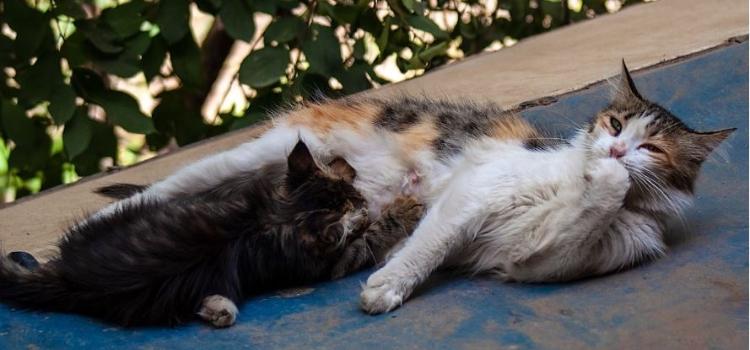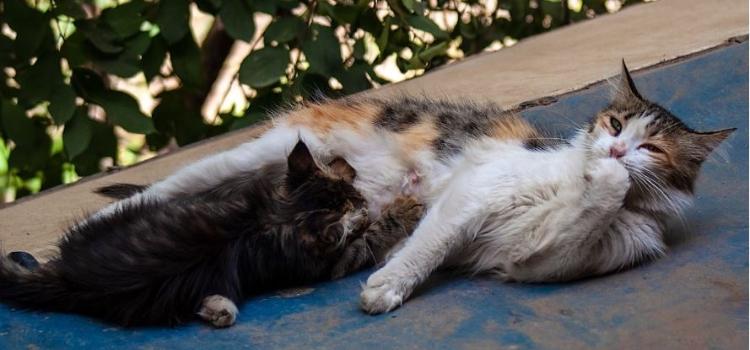As an Amazon Associate I earn from qualifying purchases.
What does cat milk taste like? Exploring the taste of cat milk: What cat parents should know.
As a committed cat parent, it is important to understand your cat’s dietary needs and preferences. Cats are not advised to take cow’s milk because they can be lactose intolerant; however, specialized kitten food is designed to meet this need. It is important to note that there is a slight difference in taste between cow’s milk and cat’s milk. Cat milk has a richer texture and more delicate taste that corresponds with the feline digestive system. Therefore if you want to cater better to your cat’s dietary requirements and make sure that they stay healthy, you need to explore the concept of tasting it. This means that we must always research everything we give our cats as responsible pet parents including information about the best types of pet foods among others such as details on how much a kitten eats per day when growing. Henceforth welcome this opportunity to sample cat milk and provide exceptional care for your lovely animals.

What is Cat Milk?
At its very core, baby cat liquid sustains early felid life stages in the most organic sense possible. This should not be confused with cow’s milk which frequently emerges in conversations on lactose intolerance. Newborn kittens depend on cat milk as their primary source of nutrition until they begin eating solid food at around four weeks old.
It contains various proteins, fats, and essential minerals which are well adjusted in terms of quantity necessary for rapid growth and development of kittens such as taurine required in maintaining good eyesight and normal heart functioning among others. Hence, apart from being tasteful like a cream, the nutritional content of cat milk is unique.
Nutritional Composition of Cat Milk
The composition of nutrients in mother cats’ breastmilk provides all the necessary elements for growth during critical periods after birth up to weaning age which occurs at around 4-6 weeks old (see also how long do cats nurse their young?) . Therefore, it should be noted that the content of fat and protein in cat milk is higher compared to others, which assists in the proper growth of kittens. Moreover, there are certain vitamins and minerals present in cow milk that are important for maintaining the good health of kittens. The nutritional composition of cat milk is meticulously adjusted to provide the best start in life for young ones. As a result, we should recognize that kittens have special diet needs and therefore cannot live without such kinds of drinks as this one. In addition to its high energy value, cat milk also contains essential nutrients needed for the healthy development of young cats.
Cat Milk Vs. Cow’s Milk
It’s paramount to understand how different cat milk is from cow’s milk. This is because cow’s milk is the staple drink for many people but not all types of animals including feline can take it normally. Cats cannot digest lactose efficiently due to a lack of necessary enzymes known as lactase; thus causing digestive discomforts or even upset stomachs because they are lactose intolerant pets whereas kitten food has essential nutrients and enzymes helpful for their growing bodies only. Thus, while choosing what will be suitable for your pet, it is crucial to remember about her or his specific dietary requirements among other factors like the right amount of food you should give your cat daily. Consequently, taste matters.
Why Is Taste Important?
Taste is a vital sense in animals that enables them to distinguish safe food. The taste preferences of cats are refined through evolutionary instincts. Appreciating the taste of cat milk allows us to comprehend a significant component of their diet and welfare.
What Does Cat Milk Taste Like?
By delving into the sensory world of our feline friends, cat milk may taste rich and sweet like other mammals’ milk which nurse their young ones. It has its flavor and texture adjusted to suit the developmental stage and dietary needs of kittens.
Flavor Profile and Textures
Concerning flavor profile and textures, this will probably be creamy cat milk with slight sweetness. It could be almost like light cream with a velvety touch on your taste buds symbolizing life sustenance for small cats to grow on hence it should be considered as an important aspect for them.This is important for their growth and development. The right nutrients are essential to ensure they grow up healthy and strong by considering their dietary needs. Flavors and textures designed around what young felines love that will also help them live well can be found in cat milk. Providing optimal nutrition is crucial for ensuring their well-being. If you feed your feline companion with this variety, you can rest assured knowing that she/he gets everything needed for a happy, healthy life.
Do Cats Enjoy the Taste?
Cats have individual tastes just like humans do; some flavors may appeal to them while others may not. However, keep in mind that sometimes cats’ interests might not remain constant throughout their lives or they may gain new likes or dislikes due to factors such as health conditions, age or past encounters with various types of eatables (Sadek et al., 2019). Thus, if your pet does not appear fond of one particular dish, do not worry about it; simply keep sampling different varieties until you come across something he/she loves eating most. Regardless of how finicky a cat might be, it must be given proper nutrition. If you find your cat not liking certain types of food, don’t give up but try to offer them different options until you find the right one for them. It is also important to meet your cat’s dietary needs even if they are uninterested in a particular food because of their individual preferences. So, just keep offering different foods and see what your cat enjoys most
Influences on Taste Preferences
It could be geographical or health factors and the number of other kinds of foods that have been introduced to the cat into an appreciation of such as well as any other type of diet. The formation of taste preferences can vary.
Considerations for Cat Parents
If you are considering giving your pet some cat milk as a treat, here are things you should bear in mind. It is important to buy high-quality brands that offer specially formulated feline milk from reputable stores.
Introducing Cat Milk
When incorporating this new diet item into your pet’s feeding regime; remember slow and steady process works best when introducing this drink gradually. Adding small amounts at a time will help gauge their reaction and prevent any stomach upsets.
Allergies and Sensitivities
When you are about to introduce any other food or drink into your cat’s diet, you must be very vigilant because there could be signs of allergies or sensitivities. Cats, just like humans, may have adverse reactions to some ingredients, and thus the a need to monitor their reaction towards cat milk. Cause for alarm should be raised when symptoms such as diarrhea, vomiting, and skin problems appear as this might indicate that your feline is having a negative response from consuming the milk. By paying attention and putting in measures to control things beforehand, one is assured of putting the health of their animals first ensuring they can still enjoy their treats without anything bad happening to them at all. Always better safe than sorry so keep an eye on new foods and drinks with your pet.
The Ethics of Consuming Cat Milk
The growing emphasis on ethical consumption has led pet owners to question the origins of products given to pets. The welfare of cats used in producing milk should be considered together with the environmental impact and sustainability issues associated with it.
The Welfare of Cats in Milk Production
For us to change this trend we must start by looking at the welfare considerations for cats. We must recognize supply chains that prioritize animal well-being. For transparency purposes, there is a need for ethical treatment of cats during milk production especially when they suffer due to neglect or poor handling by farmers. We must take responsibility not only as consumers but also to ensure these animals do not become our means for profit-making.
Environmental Impact
Also, the environmental effect of producing cat milk needs to be considered. These include factors such as water use, carbon dioxide emissions, and waste management. We must remember that this constitutes responsible pet ownership since it’s very possible that our choices as consumers are influenced by them. The current mode of spotting ethical cat milk production is by buying from sustainable companies that take full responsibility for environmental conservancy.
In general, the welfare in the milk industry for cats should come first and environmental impact should be taken into account. By being informed and ethical consumers we can support animals’ rights and a green company. Let us ensure that cats used in milk production are held in high regard because they deserve so.
Therefore, the environmental impacts of producing cat milk should also be considered. This may include among others water usage, greenhouse gas emissions, and waste disposal. In making choices as consumers, we must consider these impacts because it is a step in ethical pet caregiving. Supporting companies that are committed to sustainability and environmental stewardship can promote a more responsible approach to the production of cat milk.
The welfare of cats should be prioritized in milk production and the environmental impact on the industry considered. By choosing wisely and ethically, consumers can support businesses that put animal welfare first while still taking care of Mother Earth. Conversations about how cats involved in milk production should be handled with utmost care for their lives.
Alternatives to Cat Milk
It is important to note that not all cats can digest regular cat milk without complications. Fortunately many other options are nutritious and delicious to your pets. For example, lactose-free cow’s milk, goats’ milk or specially formulated cat milk substitutes. These alternatives contain the same vital nutrients as those found in cat’s milk but do not cause digestive complaints. To prevent negative side effects when using cat food, introduce these types of foods into its diet.
FAQ
Here are some frequently asked questions about cat milk that will give you further insights about this intriguing topic.
Can Humans Drink Cat Milk?
This is mainly because there are health implications and nutritional differences specific to species that make it unsafe for human consumption. The potential risks of allergies or indigestion far outweigh the benefits if any resulting from consuming such a drink.
Conclusion
In the main, it is always more important to think about nutrition for your pet cats rather than what you get by interacting with them. This could see you giving your cat the wrong type of milk altogether as many compositions of milk can help meet this need. Cat nutrition entails more than just the milk right?
Amazon and the Amazon logo are trademarks of Amazon.com, Inc, or its affiliates.
